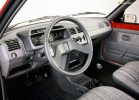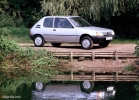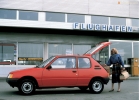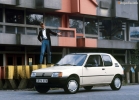PEUGEOT 205 Test drive 3 doors 1984 - 1998 hatchback
Eight in a row
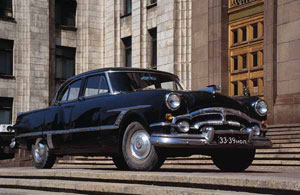 A car brand, indicated by the name of the designer or owner of the company, is a tribute to tradition and, in addition, a method that allows the latter to remain in the memory of descendants forever. In this way, they perpetuated their names Ford, Porsche, Ferrari ... The degree of perpetuation directly depends on the success of the company. And, as a result, the names of the losers and, accordingly, these stamps are usually quickly forgotten after the collapse of the firms that produced them. Moreover, these brands are often not the worst. But it happens: someone did not manage to adapt to the changed market conditions, competitors ate someone, and some, on the contrary, swallowed a too large piece, could not digest it. Errors in the development of strategy are expensive ... However, many of the deceased brands managed to leave such a bright mark in the history of auto-building (and not only auto-building) that their names (and therefore the names of the founding fathers) are still respected. .. ..
A car brand, indicated by the name of the designer or owner of the company, is a tribute to tradition and, in addition, a method that allows the latter to remain in the memory of descendants forever. In this way, they perpetuated their names Ford, Porsche, Ferrari ... The degree of perpetuation directly depends on the success of the company. And, as a result, the names of the losers and, accordingly, these stamps are usually quickly forgotten after the collapse of the firms that produced them. Moreover, these brands are often not the worst. But it happens: someone did not manage to adapt to the changed market conditions, competitors ate someone, and some, on the contrary, swallowed a too large piece, could not digest it. Errors in the development of strategy are expensive ... However, many of the deceased brands managed to leave such a bright mark in the history of auto-building (and not only auto-building) that their names (and therefore the names of the founding fathers) are still respected. .. .. 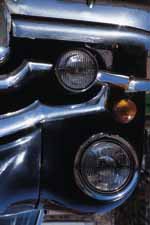 The legendary Packard brand also belongs to the disappeared, but not forgotten. It is legendary because at one time it was quoted in the world not lower than Rolls-Royce, and in America and Russia at times even higher. Take at least American presidents.
The legendary Packard brand also belongs to the disappeared, but not forgotten. It is legendary because at one time it was quoted in the world not lower than Rolls-Royce, and in America and Russia at times even higher. Take at least American presidents. William Howard Taft (1909-1913), a passionate motorist, added a lot of gray hair to his assistants, chasing Packard Avenue with a crazy speed at that time-90 km/h. (Taft is also known by the fact that in the White House stable he made a garage in which by the end of his presidency there were 5 cars, but already another, note, brands - Pierce -Arrow.)
Warren Harding (1921-1923) - for the first time in the history of the United States - arrived at his inauguration in the car. It was Packard - the Twin -Six model.
Herbert Hoover (1929-1933) drove into the Capitol in the Pierce-Arrow car, but, having registered in the White House, quite quickly changed this car to Packard. True, then the president’s love won Cadillac, and Hoover, leaving the residence forever, even acquired it into personal property.
Franklin Roosevelt (1933-1945) also honored the famous brand with his attention - most of the first two terms of his presidency, he traveled on Packard models. By the way, it was he who is accused of selling Packard Russians ...
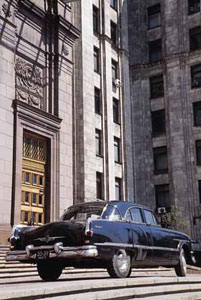 In Russia, Mark has been known since 1912, when two Packard cars were bought for the imperial garage. After the October Revolution, the country's new leadership used powerful comfortable cars with no less pleasure. They drove Lenin and Kalinin, served in the departments of Lunacharsky, Dzerzhinsky and Ordzhonikidze ...
In Russia, Mark has been known since 1912, when two Packard cars were bought for the imperial garage. After the October Revolution, the country's new leadership used powerful comfortable cars with no less pleasure. They drove Lenin and Kalinin, served in the departments of Lunacharsky, Dzerzhinsky and Ordzhonikidze ... Roosevelt, choosing a gift for Stalin, preferred the white armored Packard to the orders and a capture of the weapon. In addition, wanting to appease the Russians before difficult post -war negotiations, he convinced the company's managers to sell (at a symbolic price) tips for advice of the Senior Series Series in 1942 tips. So the ZIS-110 appeared in the USSR. It was in 1945. (In fairness, we say that the representatives of the plant, without commenting on the fact of buying stamps, argue that the ZIS -110 is purely domestic development, and it was created by direct instructions of the government as a Soviet representative car. The external resemblance to Packard is an accident ...)
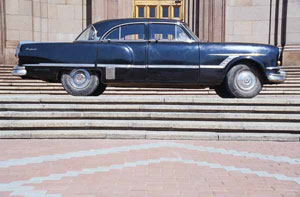 Meanwhile, despite the favorable overall atmosphere in America, the company’s affairs were not brilliant. And the point is not that after the sale of stamps, Packard remained only one outdated Clipper model (albeit in four modifications) - after the war, the Americans earned any cars enthusiastically, and competitors did not have new models. The main problem of the company was related to leaf steel deficit. General Motors, Ford and Chrysler had its own steel, and Packard had to pay for it exorbitantly. The volume of production fell ...
Meanwhile, despite the favorable overall atmosphere in America, the company’s affairs were not brilliant. And the point is not that after the sale of stamps, Packard remained only one outdated Clipper model (albeit in four modifications) - after the war, the Americans earned any cars enthusiastically, and competitors did not have new models. The main problem of the company was related to leaf steel deficit. General Motors, Ford and Chrysler had its own steel, and Packard had to pay for it exorbitantly. The volume of production fell ... Soon, competitors began to appear new models. Studebaker was first revealed - in 1946. Others followed her example. There was a real threat: Packard could supplant luxury machines from the sector - there was nothing to catch with the Clipper model there. Having gathered forces, the company in 1947 showed the public a new 22nd episode created on the basis of the 1941 Packard Phantom.
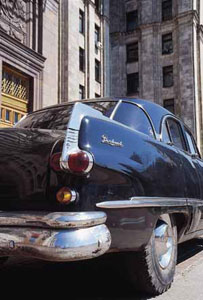 Unfortunately, the car did not go. By this time, the excitement demand for cars had declined, and the audience began to pay more attention to their appearance. And she did not like the design of new models at all that received offensive nicknames of a pregnant elephant and an inverted bath. It was not that the sales did not even help that the cars of the 22nd series were considered the most reliable in the history of the company-their mechanical filling was different in that without radical changes was used in different models since the beginning of the 30s, and there were no longer left-off fleas in it . In the 1950 model year, the release of the series was stopped.
Unfortunately, the car did not go. By this time, the excitement demand for cars had declined, and the audience began to pay more attention to their appearance. And she did not like the design of new models at all that received offensive nicknames of a pregnant elephant and an inverted bath. It was not that the sales did not even help that the cars of the 22nd series were considered the most reliable in the history of the company-their mechanical filling was different in that without radical changes was used in different models since the beginning of the 30s, and there were no longer left-off fleas in it . In the 1950 model year, the release of the series was stopped. Next year, the 24th series appeared, which many consider to be the most beautiful of all the Packard produced in the post-war period. The gamma consisted of 5 models. They differed from each other mainly by motors and details of ex- and interior. The first four were called Clipper and was equipped with engines of 4720 cm cubic meter, and the top version became the Packard 400 with a 5359 cm of the cubic meter, the direct descendant of which will be discussed below. But first we will complete the historical excursion.
 The success of the 24th series followed immediately - in the first year of production, 100 thousand cars were sold. But already in the 1952 model year, sales fell up to 63 thousand - the overproduction crisis, which began in the American automobile industry, affected. For Packard, this was a blow - when creating the 24th series, it was assumed that its release would be massive.
The success of the 24th series followed immediately - in the first year of production, 100 thousand cars were sold. But already in the 1952 model year, sales fell up to 63 thousand - the overproduction crisis, which began in the American automobile industry, affected. For Packard, this was a blow - when creating the 24th series, it was assumed that its release would be massive. With the occupation of the president’s post, the young energetic James Nance in the company began a new life: Nance tried to return Packard to the niche of luxury cars. The goal may have been set correctly, but the methods of its achievement were not always adequate to the situation ...
They retired all the old people, resumed work on the V8 engine, which started 10 years ago, shook off the dust from a patent to a torsion suspension, which the company received another ten years earlier ... These measures were supposed to bear fruit only after a year or two. In the meantime, to attract wealthy buyers, the air conditioner was returned to the salon, which were installed on Packard cars back in 1939. In addition, brakes and steering amplifiers, electric windows and electric antennas appeared on 1952 models. Sales went uphill - 93 thousand cars in 1953.
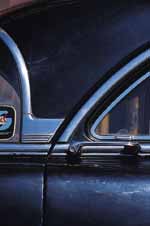 But soon luck turned away from Nance. The result of 1954 is 27 thousand cars sold. Causes? It is difficult to answer unequivocally. But one of them was late with the V8 engine: the like appeared in all competitors earlier. And although the in-line sixes and eights Packard were not inferior to V-shaped engines either in power or in a torque, customers liked the latter.
But soon luck turned away from Nance. The result of 1954 is 27 thousand cars sold. Causes? It is difficult to answer unequivocally. But one of them was late with the V8 engine: the like appeared in all competitors earlier. And although the in-line sixes and eights Packard were not inferior to V-shaped engines either in power or in a torque, customers liked the latter. It was in 1954 that Nance made a fatal mistake - in October, on his initiative, Packard united with the Studebaker company, which had the experience of releasing comfortable models that fully met the requirements of the upper class, which was obsessed with Nance. However, the financial situation of Studebaker was even worse than Packard - so there was not enough money to resuscitate both companies. And the agony of Packard began. Neither the appearance of the 275-horsepower V8 engine, nor the new body design, nor the introduction of a unique self-leveling suspension Torsion Level (deserving, by the way, of a separate story), helped. The volume of sales, however, grew up in 1955 to 68.770 copies, but the next year it fell until 13.193 - the problems with the quality that Packard had never had until then ... besides, huge funds were invested in the construction of a new motor The factory is the calculation of the subsequent sale of American Motors engines and transmission. Again, the mistake - American Motors created its own V8 motor, and the deal fell ... In 1958, the glorious brand Packard ceased to exist.
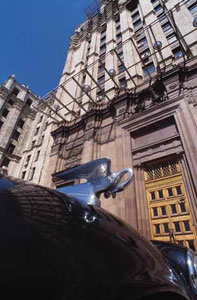 In the early 50s, the Soviet designers faced the task of creating an automatic transmission, which could be equipped with luxury class cars. As usual, decided to study foreign experience ...
In the early 50s, the Soviet designers faced the task of creating an automatic transmission, which could be equipped with luxury class cars. As usual, decided to study foreign experience ... Packard in 1949 created a rather interesting box - Ultramatic in 1949. (Note that only giants were automatic giants - General Motors, Chrysler and Borg -Warner.) The box was relatively simple - the hydrotransformer was used in it only when touched and accelerate the car, and to maintain a given speed, a special device simply blocked the secondary Val with a crankshaft - as in direct gear. Many believe that at that time it was the best box in the market - inexpensive, economical, besides, it almost did not warm and allowed the engine to slow down. She lasted in production until 1955, until the V8 engines too powerful for her appeared on Packard cars.
Apparently, the described virtues interested Soviet engineers. In the USA, several Packard cars with the Ultramatic box were purchased - to study. One of them has been preserved so far, and he fell into our hands ...
So, the car Packard. The model year is 1953. The year of release - 1952. The body type - 2652 - allows you to identify the car as Patrician Touring Sedan (it was in the 1953 model year that the car received its own name instead of index 400 - Patrician). In those days, the state still considered money in the USSR - of all the produced Packard options for study, they acquired the cheapest - for $ 3735.
The car is almost completely authentic. Everything is preserved except the mentioned gearbox. At one time, with the aim of scrupulous study, it was among other things subjected to resource tests at the stand in the design bureau of the Likhachev plant. And the box, in the end, could not stand it ...
 Sadly, but efforts were in vain. Of course, our designers were enriched with some knowledge, but the domestic analogue of the Ultramatic box could not be created. And to restore American originals - it did not work either. The next 10 years, immobilized chic cars stood quietly in the factory workshops. One of them in 1962 was purchased by an employee of the car factory (what are we, worse than Hoover, or what?). Before selling, in order to at least somehow put the car on the move, the clutch mechanism and the mechanical 3-speed gearbox were installed on it, everything from ZIS-110. At the same time, it was possible to use the automatic transmission selector on the steering column as a lever of switching of the mechanics.
Sadly, but efforts were in vain. Of course, our designers were enriched with some knowledge, but the domestic analogue of the Ultramatic box could not be created. And to restore American originals - it did not work either. The next 10 years, immobilized chic cars stood quietly in the factory workshops. One of them in 1962 was purchased by an employee of the car factory (what are we, worse than Hoover, or what?). Before selling, in order to at least somehow put the car on the move, the clutch mechanism and the mechanical 3-speed gearbox were installed on it, everything from ZIS-110. At the same time, it was possible to use the automatic transmission selector on the steering column as a lever of switching of the mechanics. The new owner actively operated the car, repairing it with the help of original parts taken from other cars from the same batch. But over time, the contents of a voracious American became too overhead, and he was put on a joke.
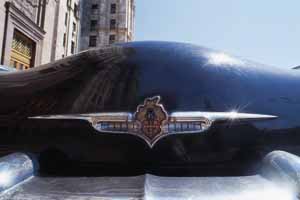 At the first glance at the car, a combination of grace and massiveness, majesty and swiftness is striking. The chrome figure of the spreading wings and the bird bowing the head on the hood is elegant, but there is something sinister in it. Someone, I remember, even tried to compare it with Odilia - a black swan ...
At the first glance at the car, a combination of grace and massiveness, majesty and swiftness is striking. The chrome figure of the spreading wings and the bird bowing the head on the hood is elegant, but there is something sinister in it. Someone, I remember, even tried to compare it with Odilia - a black swan ... In fact, everything is more prosaic. The bird is taken from the family coat of arms of the ancient English kind of Packcard. The coat of arms in 1638 was transported by Samuel Packcard to America, as for the bird, this is an ordinary pelican, which in life does not differ in the grace of the grace, greedy, mining and illegible in food. (The heraldic interpretation, however, is very romantic - the pelican bowed his head in order to tear his chest and feed blood at hungry chicks ...).
On the hoods of Packard cars, the figure appeared in 1929 - this is how they decided to perpetuate the memory of the founders of the company Ward and William Packard. In this regard, (with the aim, apparently, ennoble the image), the pelican began to be considered a cormorant, whose personal ornithological qualities from the point of view of compliance with their correct image, we note, are equally doubtful. The figure over the years of the existence of the brand has repeatedly changed, and not always for the better, but on the model of 1953, the statuette of the cups-receipt looks really elegant.
 Vertical translasting in the middle part of the three -story radiator cladding resembles shark teeth, and the bumper fangs, according to designers, imitating aircraft engines, are actually more like torpedo heads. Horizontal moldings on the front wings, smoothly dropping behind the wheeled arches and then stretch along the sides, are designed to visually facilitate the car, and violate the monotony of appearance. The theme of gills on the rear doors continue, and the brilliant vertical fins framing the stop -signals are completed.
Vertical translasting in the middle part of the three -story radiator cladding resembles shark teeth, and the bumper fangs, according to designers, imitating aircraft engines, are actually more like torpedo heads. Horizontal moldings on the front wings, smoothly dropping behind the wheeled arches and then stretch along the sides, are designed to visually facilitate the car, and violate the monotony of appearance. The theme of gills on the rear doors continue, and the brilliant vertical fins framing the stop -signals are completed. The feed of the machine, unlike the geometric front, was exquisite and circled. There is not a single plane between the pouting wings and the elegant trunk line. There are no ribs and corners - the forms smoothly flow one into the other.
Opening a wide door, you fall into the salon comparable in size to a living room. The impression is strengthened due to the presence of two sofas, which are called seats - the language does not turn. Each is designed for a volitional landing of three people. On the back is not closely and four, and only as five, the employees of our editorial office began to tie each other.
The legs can be successfully extended to their entire length: the front sofa is not a hindrance. It moves along the axis of the car - to select the optimal distance to the steering wheel and pedals. The tilt of the back is not adjustable, but the thickness and softness of the pillows provide a completely convenient planting.
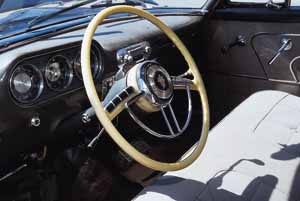 You can take a place behind the wheel without any problems - you just have to take a step into the car. The floor of the cabin is even - there is no inside, only the low tunnel of the cardan shaft passes in the center. Thanks to the huge area of \u200b\u200bglazing from the driver's seat, an excellent circular review opens. Even the absence of external rear -view mirrors does not annoy, it is enough to turn your head a little to the right or to the left, without taking your eyes off the road, and with lateral vision, you can easily control the behavior of a overtaking or (more often) overtaking car.
You can take a place behind the wheel without any problems - you just have to take a step into the car. The floor of the cabin is even - there is no inside, only the low tunnel of the cardan shaft passes in the center. Thanks to the huge area of \u200b\u200bglazing from the driver's seat, an excellent circular review opens. Even the absence of external rear -view mirrors does not annoy, it is enough to turn your head a little to the right or to the left, without taking your eyes off the road, and with lateral vision, you can easily control the behavior of a overtaking or (more often) overtaking car. The column, of course, has no adjustments, but the steering wheel is conveniently located. Its large diameter is due to the absence of any amplifiers. At first it seemed that the steering wheel rotates a tight. However, on the go, you can twist it, if not one finger, then two - for sure. It is worth releasing the steering wheel from the palms, and the wheels instantly return to the position directly. Through thin knitting needles, the dashboard consisting of a speedometer, watches and two signs is clearly visible: the fuel level and engine temperature. The signs, as it turned out, do not work - in this regard, similar workers are installed under the central part of the torpedo. Nearby is not provided for by the design, but a useful oil pressure indicator.
To the right of the steering column - an impressive ventilation control panel, with the help of two handles of which you can change the position of the damper in the ducts. Even to the right - a radio receiver of clearly Soviet production and the 50s of the release, nevertheless, connected to an automatic antenna installed on the right front wing.
The pedals are large, with large strokes and foot comfortable for legs.
The motor compartment is so huge that even a long in -line eight feels free in it. The lower engine engine looks unusual - it is rectangular, with a completely flat head, from which the bare spark plugs stick out lonely. The carburetor is nourished the size of half a bucket.
Actually, under the hood - devastation. Some ragged nozzles stick out, something is wiped with blue island. But there is no trace of rust on the back - the metal is strong, the paint is strong ... And the car is 46 years old and it is by no means a museum exhibit ...
 Before our arrival, the engine was started - for the first time in 5 years. There were no problems with the launch. I did not have them either. Turn the key in the castle, the two -three -second work of the starter, and the motor has rolled out - you can’t pick up another word. I immediately recalled that the crankshaft here - 9 -rest ...
Before our arrival, the engine was started - for the first time in 5 years. There were no problems with the launch. I did not have them either. Turn the key in the castle, the two -three -second work of the starter, and the motor has rolled out - you can’t pick up another word. I immediately recalled that the crankshaft here - 9 -rest ... The clutch pedal is tight, but the entire course is used in the work, and it is not difficult to dose the effort. The first gear is easily turned on, with clear fixation. The implantation of a mechanical box for the factory workers was a success ...
Clutch, gas ... the car has gone! The programs are switched as if by themselves, it is convenient to act as a selector - while the headlter covers the head, the thumb of the right hand glides along the rim of the steering wheel, which allows you to easily control the rotation angle.
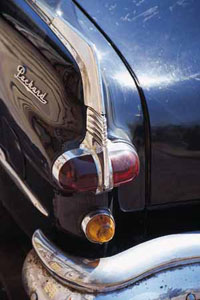 Despite the considerable weight and solid age, Patrician accelerates briskly. Here, the main role is played not by power, but by the torque of the engine, which exceeds 400 nm. The thrust occurs immediately after idle speeds and reaches a peak at 2800-3000 rpm. However, there is no need to promote the motor, it is enough to develop one and a half or two thousand revolutions in each gear. You can start from the second gear, and on a horizontal surface or under the hill - even from the third.
Despite the considerable weight and solid age, Patrician accelerates briskly. Here, the main role is played not by power, but by the torque of the engine, which exceeds 400 nm. The thrust occurs immediately after idle speeds and reaches a peak at 2800-3000 rpm. However, there is no need to promote the motor, it is enough to develop one and a half or two thousand revolutions in each gear. You can start from the second gear, and on a horizontal surface or under the hill - even from the third. Patrician maneuverability is at a height due to the large corner of rotation of the wheels. In conditions of limited space, the car can be expanded as successfully as, for example, Lada. And in the same number of tricks. No less confidently the car performs maneuvers on the road. To rebuild from a row, it is enough to move the steering wheel in the right direction. On the course, the car stabilizes clearly, without screening.
Despite the far from the ideal state of the suspension (shock absorbers are leaking, the silent blocks have been named), as well as the fact that Tchaikovskaya tires, despite its high profile, turned out to be very hard, the car soars over the road. He simply does not react to minor bumps, and overcomes large pits and bumps, only swaying slightly. The cranes of the body in corners are surprisingly small.
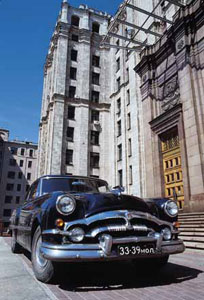 Of the shortcomings, it is worth noting the voraciousness of the machine and very stringent brakes. At first, the pedal is gently recessed in half the course - while the car does not slowly slows down. You continue to crush - you have to overcome the noticeable resistance of the pedal. Then she again goes down, almost to the floor. Sometimes, after the rocking, the machine slows down effectively and smoothly, and sometimes all the wheels are completely blocking. The fault of all this, of course, is age. But this is curable ...
Of the shortcomings, it is worth noting the voraciousness of the machine and very stringent brakes. At first, the pedal is gently recessed in half the course - while the car does not slowly slows down. You continue to crush - you have to overcome the noticeable resistance of the pedal. Then she again goes down, almost to the floor. Sometimes, after the rocking, the machine slows down effectively and smoothly, and sometimes all the wheels are completely blocking. The fault of all this, of course, is age. But this is curable ... I studied the features of management and the nature of Packard Patrician very quickly and traveled on it enough - it was difficult to deny myself such pleasure. An obvious plus when moving on a similar (present!) Car is a widespread respect for you, thanks to which the road is inferior, and the best place is given in the parking lot ... Yes, and the car is well protected from hacking or theft, since it instantly collects it at any stop. A crowd of curious.
Evgeny Romantovsky
A source: Motor magazine [No. 12/1997]

